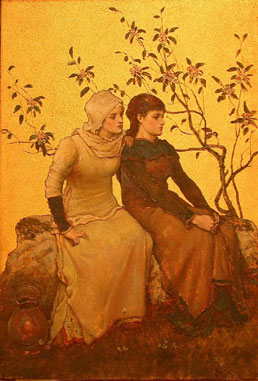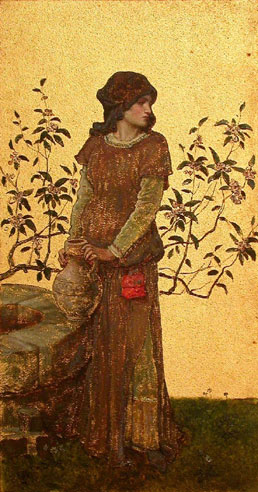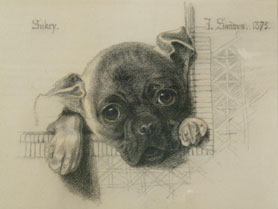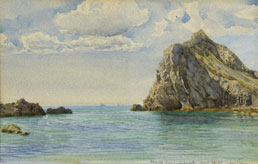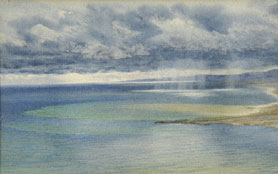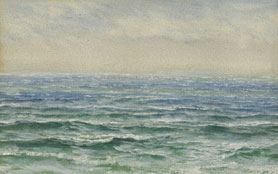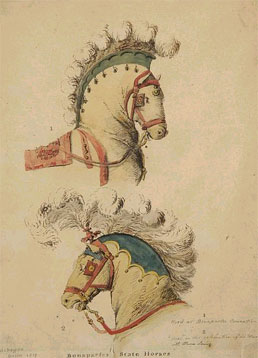|
Frederick Weekes (1833-1920)
Pre- Raphaelite Triptych
Oil on panel (3) All three Monogrammed F.W
Frederick Weekes was the son of distinguished sculptor Henry Weekes RA (1807-1877) and grew up in an artistic, antiquarian environment that nurtured a desire to train as a painter as well as an abiding and passionate interest in the history, artefacts and decoration of the Middle Ages. Weekes became a painter and an acknowledged expert on medieval costume and design, teaching at the Architectural Museum and exhibiting at the Royal Academy in the 1860’s.
It was probably through Weekes’ interest in medieval costume that he met and became associated with the leading Victorian ‘Gothic’ architect and designer, William Burges (1827-1881). The pair are known to have collected armour together (and eventually fell out acrimoniously on the subject – Weekes accusing Burges, whom he described as his ‘pupil’ of being ‘perfectly ignorant’.)
In happier times, Weekes worked very closely with Burges on a number of important projects, including Lord Bute’s Cardiff Castle and the architect’s own house, The Tower House in Holland Park, where he painted furniture and friezes. A number of painters were commissioned by Burges for such purposes but Weekes was arguably the most frequently used and knowledgeable of the architect’s clique. Weekes’ individuality and talent seems to have caused a certain amount of friction. Prof Joe Mordaunt Crook, in his book ‘William Burges and the High Victorian Dream’ states that because of his talent, Weekes “chafed unhappily as Burges’ satellite”.
Our triptych of paintings represents an exciting discovery in Weekes’ emerging oeuvre and have been dated by the leading authority in the field to the 1870s. Painted on stippled gold ground on high quality mahogany panel, the depictions of four pre-Raphaelite maidens around a well in Spring almost certainly formed part of an elaborate decorative scheme. They had languished unrecognised in a private house for most of the last century.
One possible candidate for the triptych’s original location was one of the most remarkable houses of the Victorian period: Milner Field, the home of Sir Titus Salt, the wool baron and philanthropist, who created the eponymous Saltaire, a model village for the workers in his mills. Salt’s own house, built in 1873, was an extraordinary, Wagnerian-scale mansion, constructed with every imaginable modern luxury but decorated throughout in ‘thirteenth century style’. Weekes designed a large number of decorative murals, paintings and stained glass panels for the house, some of which were removed by Salt’s widow when she left the house in 1903.
Frederick Sandys (1829-1904)
‘Sukey' signed and dated 1875
Pastel Chalk drawing
This intriguing drawing is an exciting discovery and relates to at least one and possibly two known works in Sandys’ catalogue raisonee.
The pug in our portrait is clearly very closely related to the pug puppy that appears in the 1873 portrait ‘Kittie’ (Miss Ellen Ellis) in the Walker Art Gallery in Liverpool, except that in our drawing the puppy peeps over a trellised wall, the design of which clearly relates to the wicker chair on which Miss Ellis sits in the larger portrait.
But the date on our drawing is 1875, a year in which Sandys was commissioned to produce a portrait of a pug called ‘Mischief’ belonging to the Pre-Raphaelites’ favourite antique dealer, Murray Marks. This drawing has disappeared, but perhaps the revisiting of his earlier portrait relates to this missing work.
Sandys is widely thought of as one of the great masters of chalk drawing and a significant figure in the later Pre-Raphaelite period.
Provenance:
Betty Hennell (artist's sister)
Private Collection
John Brett ARA (1830-1902), Lulworth Bay, Dorset
Oswald Bay, Lulworth, Dorset, 1870
Promontory of Naxos, Sicily, 1871
South West Gale from the Lizard, 1870
Watercolours, inscribed and dated
John Brett has been described as the landscape wing of the Pre-Raphaelite movement, with his minute attention to truthful detail and bright, almost lurid colours. His work is painstakingly ‘true’ and geographically accurate in a manner that endeared him to John Ruskin, but his landscapes – and particularly his seascapes – have a quality of heightened reality that make them almost dreamlike. Brett’s early work was in both watercolour and oil but after 1870, almost exclusively in the latter medium.
Our trio of miniature watercolours can be traced exactly, using Brett’s detailed diaries of the time, to the period just after the artist’s marriage. In fact ‘Oswald Bay’ and ‘South West Gale from the Lizard’ can be directly traced to Brett’s honeymoon trip in 1870, when he cruised along the south coast in his yacht, the ‘Viking’. The third ‘Promontory of Naxos’ dates from a trip Brett made to Italy the following year to observe an eclipse of the sun – he was a keen amateur scientist and astronomer.
Two of the three sketches seem to relate to – and could possibly be studies for - one of Brett’s most famous paintings: ‘The British Channel from the Dorsetshire Cliffs’, which can be seen at Tate Britain.
Provenance:
F.E Blackstone
Christies Sale, April 1893
Private Collection
My thanks to Charles Brett, John Brett’s great-grandson, for his help in tracing the provenance of these watercolours
Lawrence Gahagan (Irish fl 1800-1835), 'Bonaparte's Horses'
Watercolour and pencil, 1817
These two elaborately coiffed horses are an extremely rare and picturesque relic of 'Boneymania' and graphic evidence that the British obsession with 'Royalty', notoriety and celebrity is nothing new.
The sketch, by Sebastian Gahagan - scion of the famous Irish sculpting dynasty - is entitled 'Bonaparte's Horses' and accompanied by a note stating that the headgear worn by the two horses had been designed for Napoleon's coronation and his wedding to Maria Louisa.
The confusing fact for students of Napoleonic history is that the date attached to Gahagan's name on the sketch - 1817 - thirteen years after Boney's coronation and long after his wedding.
This apparently mystifying discrepancy can be explained by a possible link between the Sebastian Gahagan and the legendary Georgian museum impressario, William Bullock, who opened the first London Museum in Piccadilly in the Regency Period. Calling it the Egyptian Halls, he commissioned society sculptor Sebastian Gahagan to design the busts of Isis and Osiris that decorated its front elevation.
In 1816, Bullock had created a sensation by importing Napoleon's carriage - complete with horses - and setting it up in the museum. Londoners flocked to the exhibition - a stunt that earned Bullock the princely sum of £35,000.
We believe that these charming sketches might have been Bullock trying for an even more spectacular follow-up: from 'Napoleon's Carriage' to 'Napoleon's Marriage'. |

